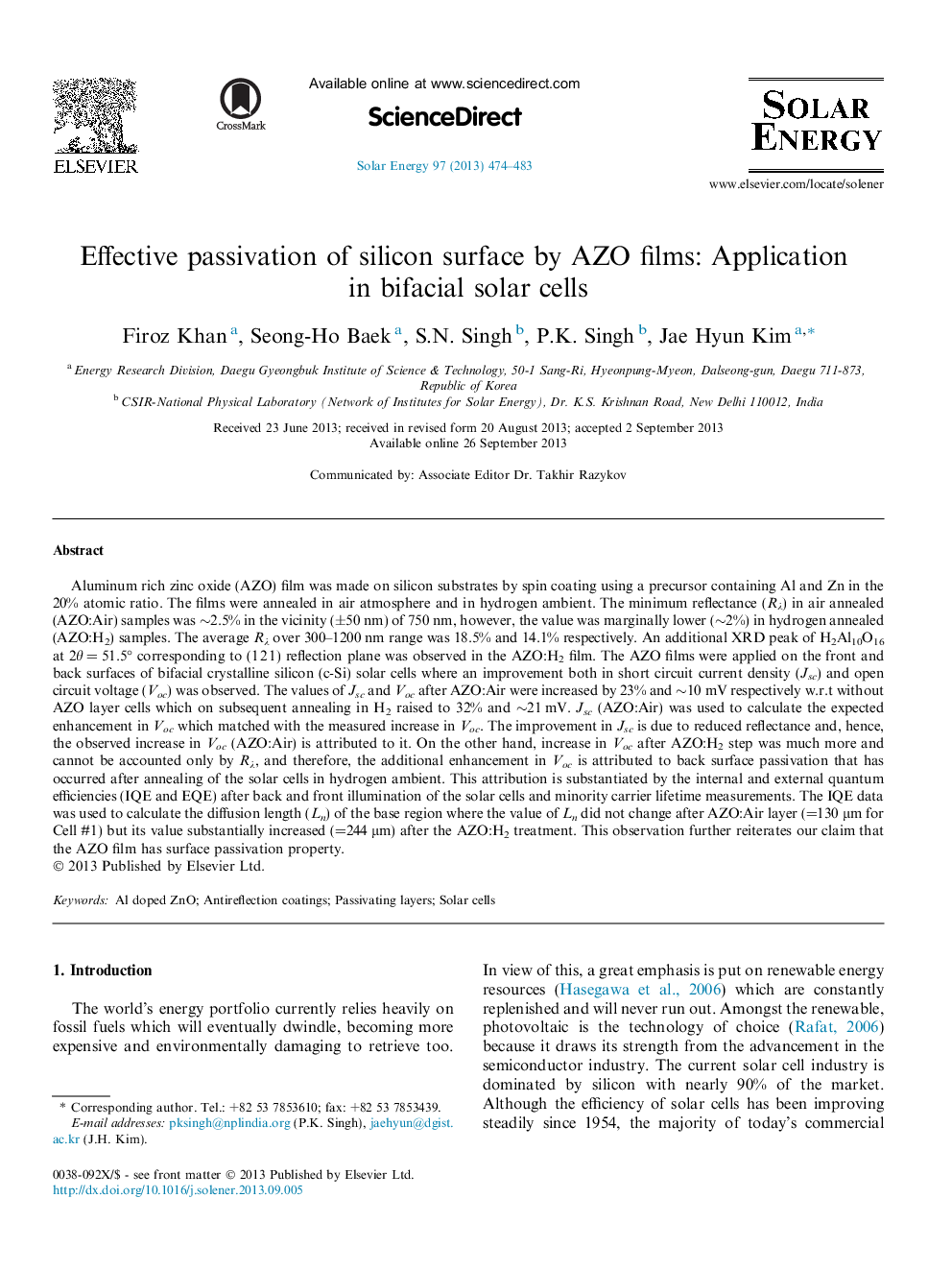| کد مقاله | کد نشریه | سال انتشار | مقاله انگلیسی | نسخه تمام متن |
|---|---|---|---|---|
| 1550370 | 1513120 | 2013 | 10 صفحه PDF | دانلود رایگان |

• Antireflection and passivation properties of hydrogen annealed AZO films were studied.
• An enhancement of ∼32% in Jsc has been achieved after hydrogen anneling.
• Improvement in Voc values were greater than the expected from Jsc enhancement.
• Front and back illuminated IQEs confirmed the passivation of p-back surface.
• A marked improvement in diffusion length was observed after AZO films annealed in hydrogen.
Aluminum rich zinc oxide (AZO) film was made on silicon substrates by spin coating using a precursor containing Al and Zn in the 20% atomic ratio. The films were annealed in air atmosphere and in hydrogen ambient. The minimum reflectance (Rλ) in air annealed (AZO:Air) samples was ∼2.5% in the vicinity (±50 nm) of 750 nm, however, the value was marginally lower (∼2%) in hydrogen annealed (AZO:H2) samples. The average Rλ over 300–1200 nm range was 18.5% and 14.1% respectively. An additional XRD peak of H2Al10O16 at 2θ = 51.5° corresponding to (1 2 1) reflection plane was observed in the AZO:H2 film. The AZO films were applied on the front and back surfaces of bifacial crystalline silicon (c-Si) solar cells where an improvement both in short circuit current density (Jsc) and open circuit voltage (Voc) was observed. The values of Jsc and Voc after AZO:Air were increased by 23% and ∼10 mV respectively w.r.t without AZO layer cells which on subsequent annealing in H2 raised to 32% and ∼21 mV. Jsc (AZO:Air) was used to calculate the expected enhancement in Voc which matched with the measured increase in Voc. The improvement in Jsc is due to reduced reflectance and, hence, the observed increase in Voc (AZO:Air) is attributed to it. On the other hand, increase in Voc after AZO:H2 step was much more and cannot be accounted only by Rλ, and therefore, the additional enhancement in Voc is attributed to back surface passivation that has occurred after annealing of the solar cells in hydrogen ambient. This attribution is substantiated by the internal and external quantum efficiencies (IQE and EQE) after back and front illumination of the solar cells and minority carrier lifetime measurements. The IQE data was used to calculate the diffusion length (Ln) of the base region where the value of Ln did not change after AZO:Air layer (=130 μm for Cell #1) but its value substantially increased (=244 μm) after the AZO:H2 treatment. This observation further reiterates our claim that the AZO film has surface passivation property.
A study of antireflection (ARC) and passivation properties of aluminium rich zinc oxide (AZO) film annealed in air (AZO:Air) and hydrogen (AZO:H2) ambient has been carried out. The films were applied on both sides of bifacial solar cells where an enhancement of ∼23% in Jsc was observed with the films annealed in air and further improvement (∼9%) was seen on subsequent annealing in hydrogen. (AZO:H2). The improvement of ∼10 mV in Voc with AZO:Air could be accounted by the enhancement in Jsc values due to ARC. On the other hand, increment of 20 mV in Voc after AZO:H2 was much larger than expected from Jsc enhancement and is attributed to the back surface passivation. The diffusion length was increased to 244 after AZO:H2 from its initial value of 130 microns.Figure optionsDownload as PowerPoint slide
Journal: Solar Energy - Volume 97, November 2013, Pages 474–483